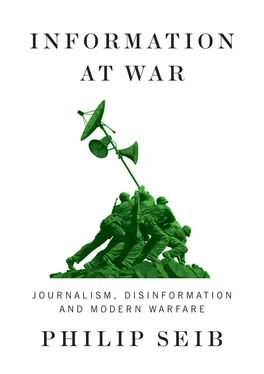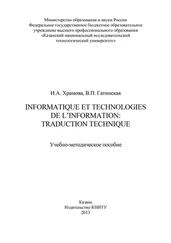Among the constituencies of conflict are those who fight wars, those who use their power to bring about and manage armed conflict, those who disseminate information about wars, and those who consume that information. This book examines slices of their shared stories, beginning in the mid twentieth century, when the rise of radio, and its bards such as Murrow and Shirer and Sevareid, marked the start of the era in which broadcasting brought timely information that helped redefine publics’ perceptions of the nature and costs of war. 4
War’s evolution has been shaped by shifts in geopolitics and by advances in technology. In scattered combat zones, states fight among themselves, against non-states (such as Al Qaeda), and sometimes against their own people (the Syrian War that began in 2011 being one example). As for the tools of war, we have moved from the longbow to the ballistic missile, and in the information universe from the messenger racing on horseback to the satellites and cellphones that reach billions.
Information at war has always been a weapon in itself – generating anger, sorrow, determination, and other facets of mass psychology that can influence the outcomes of conflict. As we will see, in the twenty-first century roles for information have become truly integral, rather than merely supplemental, parts of warfare.
Information can now circle the globe in moments, and few boundaries can stop it.
More significant than the gadgets of communication technology are the ways in which global publics have been able to use information tools to understand and affect the course of conflict. They have become more than spectators. Billions of people have devices that allow them not only to watch warriors in action, but also to tell potentially vast audiences what they themselves are seeing and add their own comments (some accurate, some not) to the flow of war-related information. Individual combatants themselves sometimes describe their views. 5Distances between fighters, professional information providers, and the public continue to shrink, while the ranks of those who share information have expanded dramatically. Twitter and its kin have become, in some cases, instruments of war.
Intensified scrutiny, both objective and biased, changes the ways in which wars are conducted. No conflict is detached from politics, and information helps tighten the connection. Information can alter the level of accountability of those who authorize and pay for wars, as well as the responsibilities of those who do the fighting. Those who decide to wage war must be able to influence – if not wholly control – information.
Henry Kissinger wrote that what has great significance in world affairs “is not only the number of people with access to information; it is, even more importantly, how they analyze it. Since the mass of information available tends to exceed the capacity to evaluate it, a gap has opened up between information and knowledge and, even beyond that, between knowledge and wisdom.” 6Ideally, thoughtful consideration of information at war will help to close that gap.
One slice of this book’s overall topic is “media and war,” which has been the subject of many studies that focus on a relationship that is in some ways symbiotic but usually maintains some level of separation between its two elements. “Media” in such analyses is usually equated with news media, and the journalism of war is a rich field that continues to produce important examinations of how wars are fought and managed. Especially in democracies, independently gathered and reported news content has long been a factor in how wars are perceived. Journalists’ depictions of a particular victory or defeat can influence public opinion and shape the course of a war. The accuracy or inaccuracy of that reporting may have profound effect on policy. This was the case during the 1968 Tet offensive in Vietnam, among other instances. That coverage and other reporting from the Vietnam War (addressed in chapter 1) has seen, over the years, its accuracy challenged, 7and it has clearly contributed to increasingly adversarial dealings between press and government. This dynamic tension fosters an environment in which the motives and even the patriotism of the protagonists have been called into question. When carried to extreme levels, such vilification may not only affect war-making but also jostle the foundations of civil society.
Fast and easy access to information through social media and other venues has changed the role of gatekeepers – traditionally the news organizations through which information has long been channeled and filtered on its way to the public. The universe of information providers is much larger today, and it keeps growing, which means the concept of “information hegemony” is increasingly obsolete. This increased number of information sources sometimes contributes to a “clash of emotions,” which can shape a political environment in ways that affect whether or how a war is fought. 8
This has led to non-journalistic media influencing warfighting in new ways. Even governments that have long controlled the information that reaches the public have learned that they can be circumvented with increasing frequency. Censors can be eluded, and firewalls can be scaled – not always, but frequently enough to broaden the range of voices making themselves heard about war. 9
In this volume, perhaps more significant than conventional issues related to news media performance during war is the weaponization of information itself. We have moved into an era beyond news media monopolization of information about armed conflict. “Information” in this context has, to an unprecedented degree, become much more than “news” as we have traditionally known it, and it is affecting warfare in ways that continue to evolve at a brisk pace. Because information has become so easy to gather – or to invent – and disseminate, state and non-state actors can wield it to stir anger, sabotage elections, and soften or stiffen the resolve of citizens who are too often treated as mere pawns in politics and conflict.
Can information start a war? Not on its own, but it certainly can influence the likelihood of one. When the Hearst and Pulitzer newspapers in the United States were screaming for war against Spain in 1898, they affected the American political environment and nudged, if not pushed, President William McKinley toward war. 10Today, an individual or group putting inflammatory material on social media can help cause civil disorder, and perhaps – in combination with other factors – incite pro-war sentiment.
Information conveyed through popular culture also can affect attitudes about war. 11 Mrs. Miniver , a British film (based on a bestselling novel) released in 1942, showed audiences in the United Kingdom and elsewhere how heroically resolute the British people were, even in the face of heavy bombing and the evacuation from Dunkirk. German propaganda minister Joseph Goebbels noted its effectiveness, saying, “There is not a single angry word spoken against Germany; nevertheless, the anti-German tendency is perfectly accomplished.” 12The Germans themselves knew the value of cinematic propaganda, as exemplified by films such as Leni Riefenstahl’s Triumph of the Will . Through the Second World War, the Cold War, and beyond, fictive and documentary films have been, to varying degrees, persuasive in how publics view specific conflicts and war generally. A detailed examination of this topic is outside the scope of this book, but it is an intriguing field for exploration.
Information’s credibility has long been affected by the venues through which it is presented, but these venues are now so plentiful that information consumers may lack the knowledge needed to distinguish among sources and weigh their relative credibility as they decide what to believe. Online content competes with the media forms to which we grew accustomed during earlier decades. YouTube rivals television; websites and the likes of Facebook and Twitter vie with print; text messaging and email supersede face-to-face conversation and provide incessant updates about events. The speed and variety of providers have few limits, and members of the public dip into various offerings with a click or a tap that unleashes a river of information that washes over them.
Читать дальше












